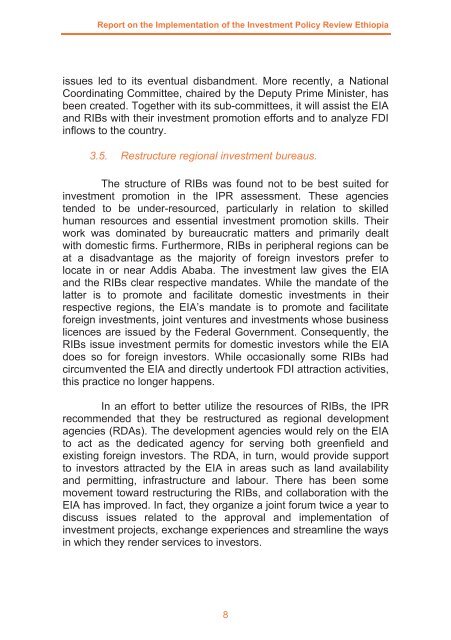Investment Policy Review Ethiopia - Unctad
Investment Policy Review Ethiopia - Unctad
Investment Policy Review Ethiopia - Unctad
Create successful ePaper yourself
Turn your PDF publications into a flip-book with our unique Google optimized e-Paper software.
Report on the Implementation of the <strong>Investment</strong> <strong>Policy</strong> <strong>Review</strong> <strong>Ethiopia</strong><br />
issues led to its eventual disbandment. More recently, a National<br />
Coordinating Committee, chaired by the Deputy Prime Minister, has<br />
been created. Together with its sub-committees, it will assist the EIA<br />
and RIBs with their investment promotion efforts and to analyze FDI<br />
inflows to the country.<br />
3.5. Restructure regional investment bureaus.<br />
The structure of RIBs was found not to be best suited for<br />
investment promotion in the IPR assessment. These agencies<br />
tended to be under-resourced, particularly in relation to skilled<br />
human resources and essential investment promotion skills. Their<br />
work was dominated by bureaucratic matters and primarily dealt<br />
with domestic firms. Furthermore, RIBs in peripheral regions can be<br />
at a disadvantage as the majority of foreign investors prefer to<br />
locate in or near Addis Ababa. The investment law gives the EIA<br />
and the RIBs clear respective mandates. While the mandate of the<br />
latter is to promote and facilitate domestic investments in their<br />
respective regions, the EIA’s mandate is to promote and facilitate<br />
foreign investments, joint ventures and investments whose business<br />
licences are issued by the Federal Government. Consequently, the<br />
RIBs issue investment permits for domestic investors while the EIA<br />
does so for foreign investors. While occasionally some RIBs had<br />
circumvented the EIA and directly undertook FDI attraction activities,<br />
this practice no longer happens.<br />
In an effort to better utilize the resources of RIBs, the IPR<br />
recommended that they be restructured as regional development<br />
agencies (RDAs). The development agencies would rely on the EIA<br />
to act as the dedicated agency for serving both greenfield and<br />
existing foreign investors. The RDA, in turn, would provide support<br />
to investors attracted by the EIA in areas such as land availability<br />
and permitting, infrastructure and labour. There has been some<br />
movement toward restructuring the RIBs, and collaboration with the<br />
EIA has improved. In fact, they organize a joint forum twice a year to<br />
discuss issues related to the approval and implementation of<br />
investment projects, exchange experiences and streamline the ways<br />
in which they render services to investors.<br />
8

















